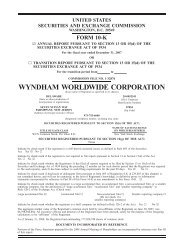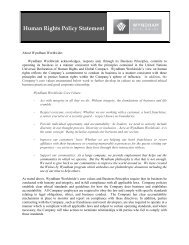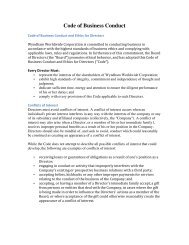WYNDHAM WORLDWIDE CORPORATION
WYNDHAM WORLDWIDE CORPORATION
WYNDHAM WORLDWIDE CORPORATION
Create successful ePaper yourself
Turn your PDF publications into a flip-book with our unique Google optimized e-Paper software.
entals business and result in the termination of approximately 330 employees. During 2008, we committed to<br />
restructuring actions and activities associated with strategic realignment initiatives targeted principally at reducing<br />
costs, enhancing organizational efficiency, reducing our need to access the asset-backed securities market and<br />
consolidating and rationalizing existing processes and facilities, which are accounted for under the guidance for post<br />
employment benefits and costs associated with exit and disposal activities. Our restructuring actions require us to<br />
make significant estimates in several areas including: (i) expenses for severance and related benefit costs; (ii) the<br />
ability to generate sublease income, as well as our ability to terminate lease obligations; and (iii) contract<br />
terminations. The amounts that we have accrued as of December 31, 2010 represent our best estimate of the<br />
obligations that we incurred in connection with these actions, but could be subject to change due to various factors<br />
including market conditions and the outcome of negotiations with third parties. Should the actual amounts differ<br />
from our estimates, the amount of the restructuring charges could be materially impacted.<br />
Income Taxes. We recognize deferred tax assets and liabilities based on the differences between the financial<br />
statement carrying amounts and the tax bases of assets and liabilities. We regularly review our deferred tax assets to<br />
assess their potential realization and establish a valuation allowance for portions of such assets that we believe will<br />
not be ultimately realized. In performing this review, we make estimates and assumptions regarding projected future<br />
taxable income, the expected timing of the reversals of existing temporary differences and the implementation of tax<br />
planning strategies. A change in these assumptions could cause an increase or decrease to our valuation allowance<br />
resulting in an increase or decrease in our effective tax rate, which could materially impact our results of operations.<br />
For tax positions we have taken or expect to take in our tax return, we apply a more likely than not threshold,<br />
under which, we must conclude a tax position is more likely than not to be sustained, assuming that the position will<br />
be examined by the appropriate taxing authority that has full knowledge of all relevant information, in order to<br />
recognize or continue to recognize the benefit. In determining our provision for income taxes, we use judgment,<br />
reflecting our estimates and assumptions, in applying the more likely than not threshold.<br />
Adoption of Accounting Pronouncements<br />
During 2011, we will adopt recently issued guidance related to the accounting for multiple-deliverable revenue<br />
arrangements. For detailed information regarding these standards and the impact thereof on our financial statements,<br />
see Note 2 to our Consolidated Financial Statements.<br />
ITEM 7A. QUANTITATIVE AND QUALITATIVE DISCLOSURES ABOUT MARKET RISK<br />
We use various financial instruments, particularly swap contracts and interest rate caps to manage and reduce<br />
the interest rate risk related to our debt. Foreign currency forwards and options are also used to manage and reduce<br />
the foreign currency exchange rate risk associated with our foreign currency denominated receivables, payables and<br />
forecasted royalties, forecasted earnings and cash flows of foreign subsidiaries and other transactions.<br />
We are exclusively an end user of these instruments, which are commonly referred to as derivatives. We do not<br />
engage in trading, market making or other speculative activities in the derivatives markets. More detailed<br />
information about these financial instruments is provided in Note 15 to the Consolidated Financial Statements. Our<br />
principal market exposures are interest and foreign currency rate risks.<br />
k Our primary interest rate exposure as of December 31, 2010 was to interest rate fluctuations in the United<br />
States, specifically LIBOR and asset-backed commercial paper interest rates due to their impact on<br />
variable rate borrowings and other interest rate sensitive liabilities. In addition, interest rate movements in<br />
one country, as well as relative interest rate movements between countries can impact us. We anticipate<br />
that LIBOR and asset-backed commercial paper rates will remain a primary market risk exposure for the<br />
foreseeable future.<br />
k We have foreign currency rate exposure to exchange rate fluctuations worldwide and particularly with<br />
respect to the British pound and Euro. We anticipate that such foreign currency exchange rate risk will<br />
remain a market risk exposure for the foreseeable future.<br />
We assess our market risk based on changes in interest and foreign currency exchange rates utilizing a<br />
sensitivity analysis. The sensitivity analysis measures the potential impact in earnings, fair values and cash flows<br />
based on a hypothetical 10% change (increase and decrease) in interest and foreign currency exchange rates. We<br />
have approximately $3.7 billion of debt outstanding as of December 31, 2010. Of that total, $330 million was issued<br />
as variable rate debt and has not been synthetically converted to fixed rate debt via an interest rate swap. A<br />
hypothetical 10% change in our effective weighted average interest rate would not generate a material change in<br />
interest expense.<br />
The fair values of cash and cash equivalents, trade receivables, accounts payable and accrued expenses and<br />
other current liabilities approximate carrying values due to the short-term nature of these assets. We use a discounted<br />
72







